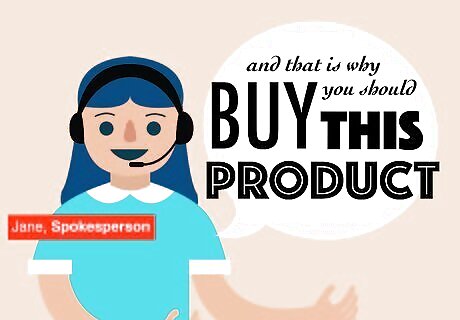
views
Creating an Infomercial

Decide what the infomercial will promote. When you start planning your infomercial's format, you’ll need to decide specifics about what you’re selling, especially if your business offers more than one product or service. Think about whether your infomercial will promote a service your small business provides, a single product it sells, or a group of products and services you offer. Infomercials are great for products that are new or not instantly recognizable in a retail environment. These products benefit from the explanation that infomercials offer. Consider your existing brand recognition and why you think an infomercial would be a good marketing strategy. Who already knows about your product or service? Are you launching a new product and need to make it more widely known? Are you trying to market a product that’s not generating the revenue you projected? Answering these questions for yourself will help you understand your specific needs and create an infomercial that better meets them.

Create an online presence. Before producing an infomercial, make sure you have a website and online payment system so viewers can easily buy your product. If you haven’t already, get a domain name that is close to the name of your small business, or the product or service you provide. There are many sites that will help you register a domain name and create a website. Choose a site fits into your budget and that offers website construction within your skill range. Ask a graphic designer friend or hire one for help building your site.

Set up an online payment system. Be sure that people have ways to remotely purchase your product. While the easiest way for people pay for your products or services is to use PayPal, you should set your site up to accept credit card payments. This will vastly broaden the number of people who can potentially buy your product or service, since more people use credit or debit cards than PayPal.

Develop a budget. An infomercial can cost anywhere from a few hundred dollars to over a million, depending on its quality and where you run it. Determine how much your small business can spend by projecting how many items you’d need to sell to recoup the infomercial’s cost. For example, if you’d need to sell 1000 items in a financial quarter to cover the cost, but typically sell 75 items per quarter, it’s unlikely an infomercial will increase your product’s movement to the point of being a justifiable cost. If your product is less than around 20 US dollars, it probably won’t be worth the investment, since you’ll never sell enough quantity to recoup the cost. If your new product doesn’t have any past sales data, try to be conservative and realistic in your projections. Don’t assume your product will leap off shelves and find yourself in debt over an unsuccessful infomercial. Keep in mind that products that sell for about five times their cost are best for infomercials. Look online or in local classifieds for freelance video editors and production specialists. Freelancers and capable students can cost between $250 and $1000 to produce an infomercial, depending on experience. Remember that an online infomercial will cost much less than a televised spot.

Pay attention to truth in advertising regulations. The Federal Trade Commission (FTC) and the Securities Exchange Commission (SEC) regulate advertisements in the US. You could face hefty fines if you promise something your product or service doesn’t provide. As you design your infomercial, make sure it does not claim anything false or misleading. Find more information about relevant laws and regulations by checking out the Direct Marketing Association’s resources: https://thedma.org/

Choose an appropriate tone for your product. As you plan out your own format, think of various tones you’ve seen in other infomercials. For example, you don’t want your infomercial spokesperson or narrator to shout if you’re selling a product that eases headaches. If you’re selling a fun kid’s product, you don’t want music that’s better fit for a funeral.

Find a spokesperson. The spokesperson will demonstrate your product’s use or narrate the infomercial. It can be you, an employee of your small business, a person who has benefited from your business, or a celebrity you hire. Think back to the target audience and tone you identified when choosing a spokesperson. Choose a spokesperson whose overall look might appeal to your target demographic. Think about appearing in your infomercial if you think your product or service would benefit from the authenticity lent by an owner/designer appearance. Let your budget have the final say when it comes to selecting a spokesperson. Don’t blow your budget on a celebrity who doesn’t have anything to do with your product or service just because of their name recognition.

Write a script. Use your infomercial to balance creativity and practicality. Its words, videos, pictures, testimonials, and footage of your service or product should all work together to convince viewers of a need and show how you can fulfill that need. Begin the script by identifying your audience’s main problem, and make a big deal of it. Think of every time you’ve heard the phrase “Are you tired of having to” at the start of an infomercial or standard commercial. Next, describe the product or service your small business provides. Discuss its benefits and how it can help the people watching your infomercial. Explain clearly how it fills that need you first described. If you can, include video that shows how it easy it is to use your product. If your product isn’t easy demonstrable, you’ll have to rely on using testimonials to make your case more convincing.

Rent a studio and equipment. If your budget allows, rent a video camera and a location, such as a local film studio or other venue appropriate for your product. While there isn't a one size fits all guide to renting or buying a camera, you should at a bare minimum have one that shoots at a resolution of 1920 x 1080p. Many affordable high resolution cameras, including some cell phone cameras, shoot at this resolution. If you rent a broadcast quality camera, make sure it has integrated audio, so you won't have to dub in an audio track during the editing process. While they perform at much higher quality, purchasing one would cost a minimum of three to four thousand dollars. Renting one runs a few hundred dollars per day. Keep in mind that higher quality cameras demand more skill, so hiring a professional to shoot the infomercial might become necessary, especially if you're planning on purchasing airtime that runs nationally.

Feature user testimonials. Whether or not it’s feasible to show your product in action, testimonials are a useful way to bolster your credibility. Ask people or companies who have worked with your small business to talk about their positive experiences. Real people who have used your products and services are essential. Avoid using paid actors, for your budget’s sake and for your credibility.

Include a strong and immediate call to action. A good infomercial compels viewers to do something immediately, whether it’s dial a number to buy the product or learn more. Ask people to buy your products, sign up for your newsletter, or visit your website. Direct customers to your small business website, or provide a phone number if you want them to order over the phone or through your business website. It’s wise to make sure you already have a cohesive brand established before investing in an infomercial: make sure you have a logo, clean website, and social media presence.

Create a presentation. Edit together your raw footage, which is composed of the problem identification, product demonstration, testimonials, and other desired graphics. Create a cohesive, logical, and entertaining presentation that fits the timeslot you’ve decided is best for your product or service. Use video editing software on your own, or if your budget allows, hire a freelance editor or a production company. Infomercials can run anywhere between a one minute segment and a half hour. Consider how long it will take to convince an audience that they need your product or service, and how long it will take to demonstrate how it fulfills that need. When editing your presentation, keep in mind viewers’ attention spans and people joining the program in progress. Design your format to comprise multiple segments repeated over the duration of your timeslot, especially if you have a full half hour.
Choosing a Platform

Figure out whether you’re targeting a specific niche or broad market. One pro of investing in an infomercial is that it can offer quick brand recognition over a region or entire nation. If you’ve thought about your existing recognition and have decided an infomercial could help your product, your next step is to start thinking about demographics and availability. Choose timeslots and format lengths that are best for your target market. For example, if you’re targeting a young adult audience, air your infomercial on a television channel that young adults watch. When you consider your market, think about where your product is already available. If it’s not exclusively available through that infomercial, at least when it first airs, then sales generated by the infomercial are unlikely to recoup the cost of investment. An infomercial is meant to generate immediate sales on its own, so if you want to improve retail sales you’ll want to consider other marketing strategies.

Buy airtime on television or online. Call a cable network or a local broadcast station and ask for rates on media buys. Choose a platform and time slot that best fits your budget. Different times and channels will come with different prices, ranging from a couple hundred dollars for an online ad to tens of thousands for a cable channel during a timeslot with modestly high viewership.

Go with affordable options like public access television. A half hour infomercial on a cable channel will run upwards of $40,000, and is thus beyond the marketing budgets of most small businesses. However, a public access channel spot can cost less than a tenth of that amount, but won’t reach nearly as broad an audience. Factor into the potential outreach that a public access spot can achieve, and decide if it’s worth it. Broadcasting locally can be great if you have a service or shop and want to appeal to your specific city or region. Remember, you can also supplement your public access infomercial with an online platform through Youtube and social media.

Consider using an online video platform. If your marketing budget doesn’t allow for airtime on a network or cable channel, it’s possible to spend a mere $1,000 on production and airtime for an online ad. Creating a Youtube video is your least expensive option. If you’re savvy with social media, a Youtube video channel can be an effective means of getting the word out about your product. If you haven't already, set up and manage Facebook, Twitter, Instagram, Snapchat, and other social media accounts for your small business. Posting a video or series of videos on a Youtube channel should include the product demonstrations, testimonials, and call to action that you'd find in a typical infomercial. You should also try to come up with a funny image or tagline to encourage viewers to check out your channel.

Use social networking to promote your infomercial. Post the link to your infomercial or video channel on your small business website, and share it on Facebook, Twitter, and other social media platforms. Invite friends to "like" it, post it on industry-related blogs, and sponsor the post on social media so it reaches as many viewers' feeds as possible. Try to create a "buzz" or to use viral or guerilla marketing strategies. These strategies will encourage your customers and supporters to share your infomercial on their sites and social networking pages. Be funny, creative, and clever to make your video campaign go viral. Just remember to keep your tone appropriate for your product. For example, if you sell a relaxing product like bath supplies, you probably wouldn't want a video featuring a man in a dinosaur suit jumping around against a neon backdrop. You would want a more soothing image and music to show how your product puts people at ease after a long day.




















Comments
0 comment